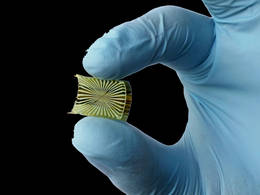A graphene-based artificial retina project has managed to intermingle the European Union’s two major FET (Future and Emerging Technologies) funding projects, 1B Euros each to be disbursed over 10 years, the Graphene Flagship and the Human Brain Project. From an Aug. 7, 2014 Technische Universitaet Muenchen (TUM) news release (also on EurekAlert),
Because of its unusual properties, graphene holds great potential for applications, especially in the field of medical technology. A team of researchers led by Dr. Jose A. Garrido at the Walter Schottky Institut of the TUM is taking advantage of these properties. In collaboration with partners from the Institut de la Vision of the Université Pierre et Marie Curie in Paris and the French company Pixium Vision, the physicists are developing key components of an artificial retina made of graphene.
Retina implants can serve as optical prostheses for blind people whose optical nerves are still intact. The implants convert incident light into electrical impulses that are transmitted to the brain via the optical nerve. There, the information is transformed into images. Although various approaches for implants exist today, the devices are often rejected by the body and the signals transmitted to the brain are generally not optimal.
Already funded by the Human Brain Project as part of the Neurobotics effort, Garrido and his colleagues will now also receive funding from the Graphene Flagship. As of July 2014, the Graphene Flagship has added 86 new partners including TUM according to the news release.
Here’s an image of an ‘invisible’ graphene sensor (a precursor to developing an artificial retina),

Graphene electronics can be prepared on flexible substrates. Only the gold metal leads are visible in the transparent graphene sensor. (Photo: Natalia Hutanu / TUM)
Artificial retinas were first featured on this blog in an Aug. 18, 2011 posting about video game Deus Ex: Human Revolution which features a human character with artificial sight. The post includes links to a video of a scientist describing an artificial retina trial with 30 people and an Israeli start-up company, ‘Nano Retina’, along with information about ‘Eyeborg’, a Canadian filmmaker who on losing an eye in an accident had a camera implanted in the previously occupied eye socket.
More recently, a Feb. 15, 2013 posting featured news about the US Food and Drug Administration’s decision to allow sale of the first commercial artificial retinas in the US in the context of news about a neuroprosthetic implant in a rat which allowed it to see in the infrared range, normally an impossible feat.